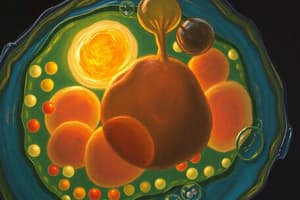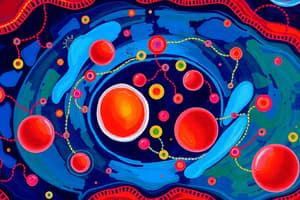Podcast
Questions and Answers
What is the primary consequence of proteins failing to fold properly?
What is the primary consequence of proteins failing to fold properly?
- Normal cellular function
- Enhanced protein degradation
- Increased protein synthesis
- Cellular apoptosis (correct)
I-cell disease is characterized by an excess of phosphorylated enzymes in the lysosomes.
I-cell disease is characterized by an excess of phosphorylated enzymes in the lysosomes.
False (B)
What is the main role of the Golgi apparatus in protein processing?
What is the main role of the Golgi apparatus in protein processing?
Modifications, packaging, and sorting of proteins.
I-cell disease results from a deficiency in the enzyme __________, which is important for phosphorylation in the Golgi apparatus.
I-cell disease results from a deficiency in the enzyme __________, which is important for phosphorylation in the Golgi apparatus.
Which of the following is a characteristic of the Golgi apparatus?
Which of the following is a characteristic of the Golgi apparatus?
Proteins destined for secretion are synthesized in the mitochondria.
Proteins destined for secretion are synthesized in the mitochondria.
Match the condition with its main effect:
Match the condition with its main effect:
What happens to lysosomal enzymes in patients with I-cell disease?
What happens to lysosomal enzymes in patients with I-cell disease?
Which of the following diseases is caused by a deficiency in the enzyme hexosaminidase A?
Which of the following diseases is caused by a deficiency in the enzyme hexosaminidase A?
Peroxisomes are responsible for the breakdown of gangliosides.
Peroxisomes are responsible for the breakdown of gangliosides.
What primary defect characterizes Hurler Syndrome?
What primary defect characterizes Hurler Syndrome?
The enzyme that converts H2O2 to H2O and O2 in peroxisomes is called __________.
The enzyme that converts H2O2 to H2O and O2 in peroxisomes is called __________.
What is the typical age of onset for the most common form of Tay-Sachs Disease?
What is the typical age of onset for the most common form of Tay-Sachs Disease?
Lysosomal storage diseases are primarily autosomal dominant diseases.
Lysosomal storage diseases are primarily autosomal dominant diseases.
Name one major function of lysosomes.
Name one major function of lysosomes.
Zellweger syndrome is characterized by the accumulation of __________ in the blood.
Zellweger syndrome is characterized by the accumulation of __________ in the blood.
What is a common clinical finding in individuals with Tay-Sachs Disease?
What is a common clinical finding in individuals with Tay-Sachs Disease?
Match the disease with its cause:
Match the disease with its cause:
Lysosomes provide an alkaline environment to aid in digestion.
Lysosomes provide an alkaline environment to aid in digestion.
What is the major site of new membrane synthesis in the cell?
What is the major site of new membrane synthesis in the cell?
Individuals with Hurler Syndrome may exhibit __________ and intellectual disabilities.
Individuals with Hurler Syndrome may exhibit __________ and intellectual disabilities.
What type of proteins are involved in the formation of peroxisomes?
What type of proteins are involved in the formation of peroxisomes?
What important process do peroxisomes help with concerning fatty acids?
What important process do peroxisomes help with concerning fatty acids?
Which of the following is a characteristic of Progeria?
Which of the following is a characteristic of Progeria?
Mitochondrial dysfunction can lead to symptoms in skeletal muscle fibers.
Mitochondrial dysfunction can lead to symptoms in skeletal muscle fibers.
What is the primary function of mitochondria in cells?
What is the primary function of mitochondria in cells?
The mutation in the nuclear lamina gene associated with Progeria results in the production of a protein called __________.
The mutation in the nuclear lamina gene associated with Progeria results in the production of a protein called __________.
Match the following types of proteins with their functions:
Match the following types of proteins with their functions:
Which lipids are the most abundant in the plasma membrane?
Which lipids are the most abundant in the plasma membrane?
All mitochondria in an organism originate from both parents.
All mitochondria in an organism originate from both parents.
What is the role of flippases in the plasma membrane?
What is the role of flippases in the plasma membrane?
Mitochondria are often referred to as the __________ of the cell.
Mitochondria are often referred to as the __________ of the cell.
Which of the following statements about glycolipids is true?
Which of the following statements about glycolipids is true?
Cholesterol makes the plasma membrane more fluid and permeable.
Cholesterol makes the plasma membrane more fluid and permeable.
What is a unique feature of mitochondrial DNA (mtDNA)?
What is a unique feature of mitochondrial DNA (mtDNA)?
Diseases caused by mitochondrial dysfunction are termed __________ myopathies.
Diseases caused by mitochondrial dysfunction are termed __________ myopathies.
Which organelle contains the machinery for oxidative phosphorylation?
Which organelle contains the machinery for oxidative phosphorylation?
Flashcards
Apoptosis
Apoptosis
The process where a cell destroys itself. This happens when proteins fail to fold correctly, potentially causing harm to the cell.
Signal Sequence
Signal Sequence
A sequence of amino acids on a protein that is essential for its transportation to the endoplasmic reticulum (ER) during translation.
Endoplasmic Reticulum (ER)
Endoplasmic Reticulum (ER)
A network of interconnected membranes within a cell. It is involved in protein synthesis and transport.
Golgi Apparatus
Golgi Apparatus
Signup and view all the flashcards
Cis Face
Cis Face
Signup and view all the flashcards
Trans Face
Trans Face
Signup and view all the flashcards
I-Cell Disease
I-Cell Disease
Signup and view all the flashcards
Lysosomes
Lysosomes
Signup and view all the flashcards
Membrane-enclosed organelles
Membrane-enclosed organelles
Signup and view all the flashcards
Plasma membrane
Plasma membrane
Signup and view all the flashcards
Phospholipids
Phospholipids
Signup and view all the flashcards
Outer leaflet
Outer leaflet
Signup and view all the flashcards
Inner leaflet
Inner leaflet
Signup and view all the flashcards
Cholesterol
Cholesterol
Signup and view all the flashcards
Integral membrane proteins
Integral membrane proteins
Signup and view all the flashcards
Peripheral membrane proteins
Peripheral membrane proteins
Signup and view all the flashcards
Transmembrane proteins
Transmembrane proteins
Signup and view all the flashcards
Fluidity of membrane proteins
Fluidity of membrane proteins
Signup and view all the flashcards
Nucleus
Nucleus
Signup and view all the flashcards
Nucleolus
Nucleolus
Signup and view all the flashcards
Mitochondria
Mitochondria
Signup and view all the flashcards
Cristae
Cristae
Signup and view all the flashcards
Mitochondrial DNA (mtDNA)
Mitochondrial DNA (mtDNA)
Signup and view all the flashcards
Mitochondrial Diseases
Mitochondrial Diseases
Signup and view all the flashcards
mtDNA Ratio Threshold
mtDNA Ratio Threshold
Signup and view all the flashcards
Diagnosis of Mitochondrial Diseases
Diagnosis of Mitochondrial Diseases
Signup and view all the flashcards
Functions of Lysosomes
Functions of Lysosomes
Signup and view all the flashcards
Lysosomal Storage Diseases (LSD)
Lysosomal Storage Diseases (LSD)
Signup and view all the flashcards
Inheritance Pattern of LSDs
Inheritance Pattern of LSDs
Signup and view all the flashcards
Consequences of LSDs
Consequences of LSDs
Signup and view all the flashcards
Tay-Sachs Disease
Tay-Sachs Disease
Signup and view all the flashcards
Ganglioside Accumulation in Tay-Sachs
Ganglioside Accumulation in Tay-Sachs
Signup and view all the flashcards
Symptoms of Tay-Sachs Disease
Symptoms of Tay-Sachs Disease
Signup and view all the flashcards
Hurler Syndrome
Hurler Syndrome
Signup and view all the flashcards
Glycosaminoglycans (GAGs) in Hurler Syndrome
Glycosaminoglycans (GAGs) in Hurler Syndrome
Signup and view all the flashcards
Diagnosis of Hurler Syndrome
Diagnosis of Hurler Syndrome
Signup and view all the flashcards
Peroxisomes
Peroxisomes
Signup and view all the flashcards
Catalase in Peroxisomes
Catalase in Peroxisomes
Signup and view all the flashcards
Study Notes
Cell Structure and Function
- Course: MANS 433
- Instructor: Adam Gromley, Ph.D.
- Email: [email protected]
- Reading Assignments:
- Essential Cell Biology, Chapter 1
- Essential Cell Biology, Chapter 11
- Marks' Basic Medical Biochemistry, Chapter 10
Lecture Objectives
- Identify the lipid, protein, and carbohydrate components of the plasma membrane
- Describe the basic functions of the plasma membrane, including selective permeability, cellular communication, and physical barrier functions
- Identify the major ions found inside the cell and in the extracellular environment, as well as explain the variations of ion concentrations across cell membranes
- Identify the six major membrane-bound organelles of the human cell
- Describe the structure and major functions of each organelle
- Identify genetic diseases associated with dysfunction of the nuclear lamina, mitochondria, lysosomes, peroxisomes, and Golgi apparatus
- Explain the molecular process affected in each
- Apply the knowledge to relevant clinical concepts
Cells
- Cells are small, membrane-enclosed units filled with a concentrated aqueous solution of chemicals
- They have the ability to create copies of themselves by growing and dividing in two
- A cell is the smallest unit of life
Classifications of Living Organisms
- All living organisms can be classified into two basic groups:
- Prokaryotes
- Eukaryotes
Components of Prokaryotic Cells (Bacteria)
- Typically possess a flagellum for movement
- Lack membrane-bound organelles
- DNA is in the cytoplasm, connected to the cell membrane
- Nucleoid
- Cell membrane is enclosed by a cell wall
Bacterial Cell Wall
- Composed of peptidoglycan (murein)
- Mesh-like layer with carbohydrate backbones that are cross-linked by peptide bridges
- Some classes of antibiotics inhibit bacterial cell wall formation, preventing peptidoglycan synthesis
- Examples:
- Beta-lactams
- Penicillin
- Glycopeptide antibiotics
- Vancomycin
Hierarchy of Multicellular Organisms
- Organs are comprised of tissues
- Tissues are made up of specialized cells
- Cells in organs perform specific functions
- Different cell types have similar components
Components of Eukaryotic Cells (Animal Cells)
- Plasma Membrane
- Membrane-enclosed organelles
- Nucleus
- Mitochondria
- Lysosomes
- Peroxisomes
- Endoplasmic Reticulum
- Golgi Apparatus
- Cytoskeleton
Prokaryotic vs. Eukaryotic Cells
- Prokaryotes are unicellular
- Eukaryotes are multicellular
- Prokaryotic cells have a cell wall
- Eukaryotic cells have a cell membrane
- Prokaryotic cells lack membrane-bound organelles, while eukaryotic cells have many
- Prokaryotic DNA is not enclosed in a nucleus. Eukaryotic DNA is enclosed in a nucleus
- Prokaryotic cells are typically smaller than eukaryotic cells
Plasma Membrane
- Sometimes referred to as plasmalemma
- Surrounds the cell and separates the cell's contents from the outside environment
- Composed of a phospholipid bilayer with: Two hydrophobic fatty acid tails and a hydrophilic head
- Selectively permeable to ions and organic molecules
- Associated proteins include:
- Integral membrane proteins (permanently associated)
- Peripheral membrane proteins (transiently associated)
Plasma Membrane: Major Components
- Lipids: About 50% of membrane volume, including
- 75% phospholipids
- 20% cholesterol
- 5% glycolipids
- Faces the outside (extracellular) environment
- Proteins:
- ~ 50% of membrane volume
Lipids
- Three main families found in plasma membranes:
- Phospholipids (most abundant)
- Glycolipids (lipid attached to a sugar molecule)
- Cholesterol (about 20% of the lipid composition of the plasma membrane)
Phospholipids
- Amphipathic (possess both hydrophobic and hydrophilic regions)
- Consist of five parts:
- Hydrophilic head (polar)
- Glycerol
- Phosphate group
- Two nonpolar hydrocarbon tails (originating from fatty acids)
Phospholipids in the Plasma Membrane
- Phosphatidylethanolamine
- Phosphatidylserine
- Phosphatidylcholine
- Sphingomyelin
Phospholipid Bilayer
- Phospholipids form a bilayer in aqueous solution
- Bilayer is asymmetrical
- Outer leaflet faces the extracellular environment
- Inner leaflet faces the cytoplasm
- Lipid bilayer is a two-dimensional fluid structure
- Individual phospholipids can exchange positions within the same monolayer (lateral diffusion) but rarely between layers (flip-flopping)
Glycolipids
- Backbone is a sphingosine molecule
- Contains a short carbohydrate molecule
- Found in the outer leaflet of the plasma membrane
- Have important roles in cell recognition
- Examples:
- Cerebrosides
- Gangliosides
Membrane Lipids and Signal Transduction
- Lipids found in the plasma membrane function in many different types of cellular signaling pathways
Cholesterol
- Constitutes roughly 20% of the lipid composition of the plasma membrane
- Fills the spaces between phospholipids
- Makes the plasma membrane more rigid and less permeable
Proteins in the Plasma Membrane
- Four ways proteins are associated with the plasma membrane
- Transmembrane
- Monolayer-associated
- Lipid-linked
- Protein-attached
Transmembrane Proteins
- Span both layers of the plasma membrane
- Four Classes:
- Transporters
- Anchors
- Receptors
- Enzymes
Fluidity of Membrane Proteins
- The plasma membrane is a fluid structure
- Membrane proteins can move laterally within the membrane
Functions of the Plasma Membrane
- Communication (has receptors for responding to molecular signals)
- Physical barrier (phospholipid bilayer separates interior and exterior)
- Intercellular connection (establishes a flexible boundary, protects cellular content, and supports cell structure)
- Selective permeability (regulates entry and exit of ions, nutrients, and waste molecules)
Lipid Bilayers and Their Impermeability to Solutes and Ions
- Small nonpolar molecules easily diffuse across the lipid bilayer
- Examples:
- Oxygen
- Carbon dioxide
- Nitrogen
- Benzene
- Examples:
- Small uncharged polar molecules can cross the bilayer
- Water
- Ethanol
- Large uncharged polar molecules and ions require alternative methods to enter the cell
- Examples:
- Glucose
- Amino acids
- Na+
- K+
- H+
- Cl-
- Examples:
Ion Concentrations Inside/Outside a Cell
- Ion concentration inside a cell differs from outside
- This difference creates an electrochemical gradient
Membrane-Enclosed Organelles
- A list of organelles located within eukaryotic cells.
Nucleus
- The most prominent organelle
- Stores DNA (information storage)
- Contains a nuclear envelope/membrane (two lipid bilayers; inner and outer nuclear membrane)
- Nuclear pore complex
- Chromatin
- Nucleolus
Nuclear Envelope Dysfunction (example: Progeria)
- Very rare, fatal childhood disease characterized by premature aging
- Associated with mutations in the nuclear lamina gene (lamin A)
Mitochondria
- Membrane-bound organelles (less than 1µm)
- Enclosed by two membranes (outer and inner)
- Inner membrane has cristae (in-foldings to increase surface area)
- Contains the matrix (space enclosed by inner membrane)
- Many copies per cell, the quantity depending on the cell type's metabolic needs
Functions of Mitochondria
- "Power plants of the cell"; produces ATP (energy)
- Oxidative phosphorylation
- Metabolic and biosynthetic processes, including
- Beta oxidation of fatty acids
- Heme synthesis
- Steroid synthesis
- Apoptosis (programmed cell death)
Unique Characteristics of Mitochondria
- Self-replicate via fission
- All mitochondria in an organism originate from the mother
- "Non-Mendelian inheritance" (mDNA, not from both parents)
- Encodes some proteins required for function. The rest are encoded in the nuclear DNA.
Mitochondrial Dysfunction (examples, symptoms, etc)
- Neuromuscular disease symptoms
- Mitochondrial defects, especially if high-energy metabolism is involved
- Caused by mutations in mitochondrial or nuclear DNA
- Vaguely defined symptoms
Lysosomes
- Small (less than 0.5µm), membrane-bound organelles
- Contain hydrolytic enzymes (digestive enzymes)
- "Stomach of the cell"
- Breaks down various substances and organelles
- Important for innate and adaptive immunity (pathogen digestion by phagocytosis)
Lysosomal Dysfunction
- lysosomal storage diseases cause abnormal accumulation of substances inside the cell. This may increase the affected tissue’s mass (Brain in neurodegeneration for instance)
- Affects children often and causes them to die after a few years.
Tay-Sachs Disease
- Deficiency in the enzyme hexosaminidase A (Hex A)
- Enzyme normally breaks down ganglioside in the brain
- Accumulation of ganglioside results in gangliosides neuronal cell death
- Infantile Tay-Sachs: Neurological damage starts around 3-6 months and progresses until the child dies between 2-4 years old
Hurler Syndrome
- Defect in the enzyme a-L-iduronidase
- Enzyme that breaks down glycosaminoglycans (GAGs)
- Accumulation of undigested GAGs within the lysosomes
- Affected individuals exhibit skeletal abnormalities and intellectual disabilities
Peroxisomes
- Small, membrane-bound vesicles similar to lysosomes
- Contain enzymes for oxidative reactions—including catalase (to convert H2O2 to H2O + O2)
- Involved in the breakdown of very long-chain fatty acids, involved in various metabolic and biosynthetic processes
- Involved in degradation of substances like ethanol.
Peroxisomal Dysfunction (example: Zellweger Syndrome).
- Autosomal recessive disorders from mutations in peroxins
- Results in the accumulation of very long-chain fatty acids.
- Zellweger syndrome occurs with impaired brain development, liver and kidney diseases
- Diagnosed (often) through fatty acid levels in the blood
- Usually fatal within the first year of life.
Endoplasmic Reticulum (ER)
- Membrane-bound system of interconnected sacs and tubes
- Continuous with nuclear membrane
- Two types:
- Smooth ER (major site for new membrane synthesis)
- Rough ER (large areas associated with ribosomes; make secretory proteins)
- Sarcoplasmic Reticulum (smooth ER in muscle cells) -important for calcium storage
- Unfolded protein response (UPR)—quality control of newly synthesized proteins; commits “cellular suicide” when proteins do not fold properly.
Protein Translation in the ER
- Proteins destined for the plasma membrane or incorporation into vesicles are synthesized
- A signal sequence directs the ribosomes to the ER to ensure correct processing
Golgi Apparatus
- Located near the nucleus; ER-derived
- Stacks of flattened membrane-enclosed sacs (cisternae)
- Has polarity: cis face (receives) and trans face (releases)
- Modifications, packaging, and sorting of proteins and enzymes destined for lysosomes or plasma membranes
Protein Trafficking and Sorting
- Different pathways for transporting proteins in the cell, including packing into vesicles, transport to different organelles (like lysosomes), and secretion.
Golgi Apparatus Dysfunction (example: I-cell disease)
- Rare inherited condition clinically characterized by defective physical growth and intellectual disabilities
- Deficiency of a phosphorylating enzyme (normally found in the Golgi apparatus)
- Consequently, lysosomal enzymes coming from the rough ER are not phosphorylated
- Unphosphorylated enzymes aren't directed to lysosomes; they are released outside the cell
- Lysosomes lack necessary enzymes; accumulation of undigrated proteins (secreted)
Studying That Suits You
Use AI to generate personalized quizzes and flashcards to suit your learning preferences.
Related Documents
Description
This quiz covers key concepts from Essential Cell Biology and Marks' Basic Medical Biochemistry, focusing on the structure and functions of the plasma membrane and organelles. Students will explore topics such as membrane composition, ion concentrations, and genetic diseases related to organelle dysfunction.




